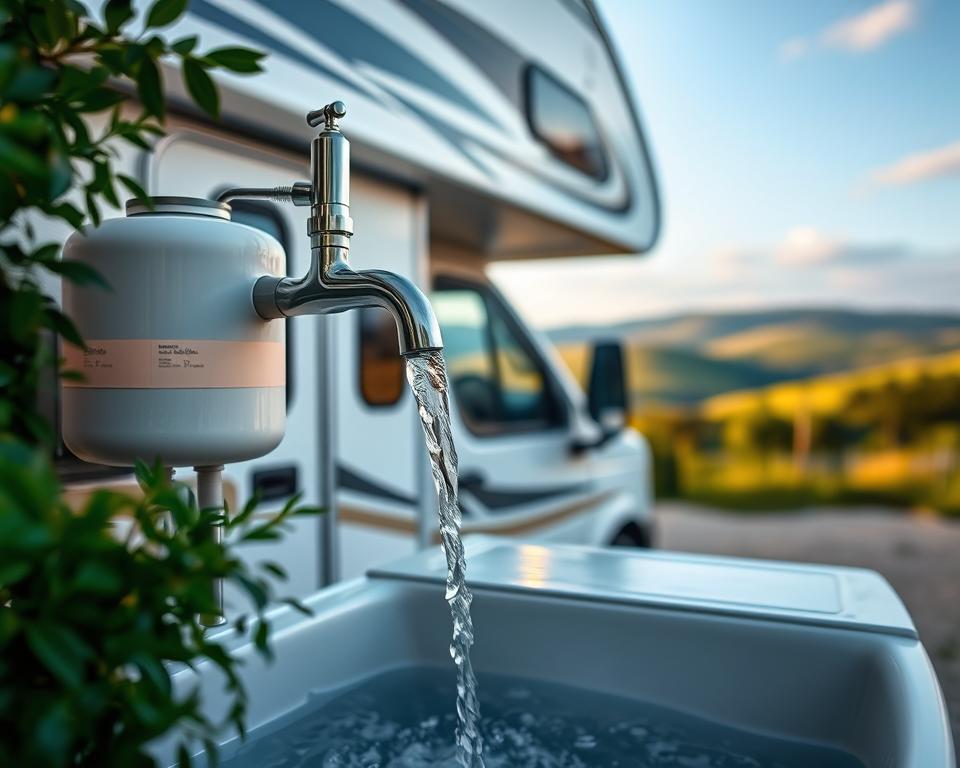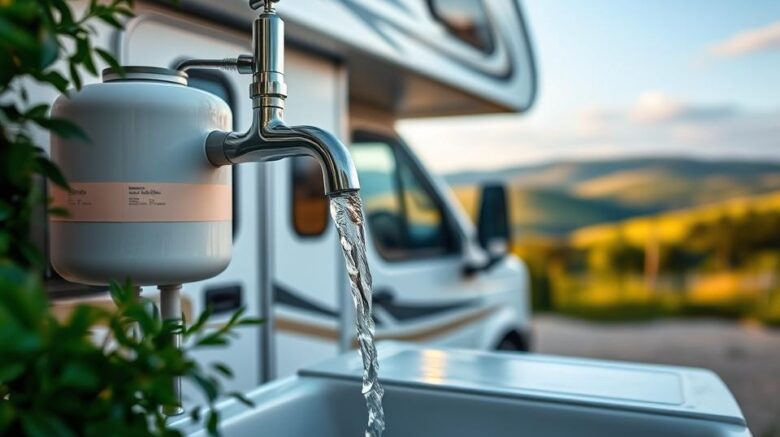Camper Waste Pump Manual: Key Maintenance Advice
Have you given thought to the workings of your recreational vehicle sewage network? Being aware of the intricacies of your RV waste pump can sidestep mishaps, improving your camping trips. It’s centered on handling waste efficiently and avoiding noxious odors. By following this guide, you’ll discover essential maintenance strategies for RV black water tank pump. Each crafted to maintain your waste disposal system’s ideal functionality.
Grasping Your RV Sewer Pump System
The camper sewage pumping setup is indispensable for sewage control, making RV outings more convenient. It features two principal tanks: the black water tank for toilet waste and the sink/shower runoff tank for water from wash basins and shower stalls. Telling apart these tanks is key to ward off clogs and keep your RV operating smoothly.
An camper macerator unit is a common selection for sewage handling. It pulverizes solid waste into tiny bits, easing disposal. In contrast, a standard waste pump is available. It smoothly moves waste without pulverizing, for those wanting a simpler option.
Understanding your RV’s sewer pump system is crucial to stopping problems and ensuring trouble-free evaluations. Managing the system effectively can prevent messes, improving your outdoor adventures.
Importance of Regular Maintenance
Servicing your RV sewer pump is crucial for a seamless trip. Without proper maintenance, you may run into odors, clogs, or backups. These glitches can mar your road trips.
Scheduled upkeep stop such problems and sustain your system’s life. By checking hoses and seals, you maximize efficiency. A duly maintained RV sewage pump guarantees smooth waste disposal, letting you enjoy uninterrupted travels.
Ongoing care also brings financial savings over time. Neglect can cause significant problems, requiring expensive replacements. Investing in regular maintenance keeps your motorhome in prime shape, conserving money long term.
How Frequently to Service Your RV Septic Tank?
Determining the proper interval to service your RV Septic Tank is key for its upkeep. It’s best practice to pump every three to five days during use. For short trips, post-trip emptying may work fine.
Interval depends on several factors. Tank capacity and usage level are vital. Ideally pump when it reaches two thirds. This helps ensure steady waste movement and ward off blockages.
Monitoring your RV Septic tank levels is vital for a smooth journey. Handle your camper’s sewage to stop issues while traveling.

Recommended Tank Emptying Tips
Accurately discharging RV tanks is key for your motorhome’s cleanliness and reliability. Start with the black water tank to let the grey water rinse leftover solids. This strategy stops clogs and ensures smooth operation.
Choose a top-grade drain hose for disposal. A robust hose avoids leaks and locks connections. Add a tank rinser for a complete flush, using water pressure to remove remaining debris, improving cleanliness.
Thorough draining prevents residue buildup, avoiding foul odors and potential issues. To maintain an effective sewage system in your motorhome, adhere to these guidelines:
- Regularly use a tank treatment to keep odors at bay and digest residue.
- Watch capacity to avoid leaks.
- Perform routine pump inspections for clogs and wear.
- Perform a deep tank flush every 4–8 weeks, even during less frequent trips.
Following these methods enhances your sewage system’s lifespan and efficiency, ensuring enjoyable travels.
Keeping Smells and Blockages at Bay
For a enjoyable trip, preventing foul aromas is key. Keep enough water in tanks to aid in breaking down waste, stopping unpleasant odors. Also, opting for RV-approved tissue helps prevent clogs, avoiding backups.
For better sewage management in campers, try enzyme-based tank treatments. These effectively break down waste, easing upkeep. Check the vent line often to keep air moving freely in the plumbing system.
Mindful disposal is crucial to avoiding tank issues. Do not flush wipes, feminine products, and paper towels. These non-biodegradable items can cause major clogs. Using these practices helps maintain a neater camping environment.
RV Sewer Pump Maintenance Tips
Maintaining your RV’s sewer pump system is essential for trouble-free travels. Inspect dump valve seals regularly to stop seepage. Leaky seals can cause accidents, harming your RV.
To eliminate odors and maintain cleanliness, sanitizing is vital. Perform a deep clean every few months to stop residue accumulation, ensuring the system performs reliably. These steps are necessary for maintaining a on-board grinder, promoting durability and efficient operation.
Greasing valve components is another important task. It helps avoid drips and enhance functionality. Checking sensor accuracy is vital for correct levels, preventing overflows and unexpected pump issues. Staying on top of these checks makes your RV adventures cleaner and more enjoyable.
Indicators You Need Expert Pumping
Identifying septic problems ahead can protect you from costly repairs. A key sign you need a professional pump-out is slow draining. When sinks and toilets take longer to clear, it often points to blockages. It suggests your system may be jammed.
Ongoing foul scents are another clear sign of sewage troubles. Unpleasant fumes hanging around despite cleaning suggest trapped waste. It’s crucial to check the transparent elbow fitting when dumping waste. Remaining waste visibility signals it’s time for professional pump service.
Technicians utilize jet machines to dismantle stubborn blockages efficiently. Neglecting these signs can grow into major problems. Therefore, it’s essential to seek help immediately when issues arise.
| Indicators of Sewer Trouble | Recommended Response |
|---|---|
| Slow Draining | Inspect for clogs; arrange professional pump-out |
| Persistent Odors | Check vents; contact pro service |
| Visible Waste Residue | Call pro for deep cleanse |
Choosing the Right RV Macerator Pump
When picking an RV macerator pump, assess its volume handling, durability, and compatibility with your RV’s size. A top-notch macerator is vital for effective waste grinding. This is especially important for RVs requiring frequent disposals. High-end pumps boost sewage handling, ensuring a better travel experience.
Various units cater to specific demands. For an educated choice, focus on these essential considerations:
- Capacity: Ensure the pump can handle your RV’s waste output.
- Durability: Opt for models built to endure travel demands.
- Ease of Use: Look for user-friendly pumps.
- Compatibility: Check plumbing compatibility.
Taking time to compare when choosing an RV macerator pump optimizes travel enjoyment and ensures efficient pump performance.
RV Sewer Pump Problem-Solving
Proper troubleshooting for your RV sewer pump is key in rectifying common sewage issues before they worsen. If you notice slow drainage, unplanned backflows, or persistent odors, act quickly. These are clear signs of malfunction requiring attention.
Start with checking the pump, its connections, and hoses. Check for any clogs that could slow flow. Ensure inlet and outlet fittings are secure. Also, verify the pump’s power supply for reliable current.
If basic checks don’t detect the issue, note the pump’s sound. A unit that’s overly noisy or too quiet may have internal damage. Also, inspect for leaks, as these can exacerbate sewage problems. With these troubleshooting steps, many RV owners identify and fix issues early, avoiding costly repairs.
Long-Term RV Sewer Pump Care
For continued reliability, dedicate yourself to regular sewer pump upkeep. Clean the system consistently to prevent clogs. Set up and observe a maintenance routine, keeping everyone informed of their roles. This significantly increases your waste system’s lifespan.
Educating yourself and others on proper waste disposal is essential. This forestalls issues and fosters shared responsibility. The result benefits both users and the sewer system.
- Routine inspection of hoses and connections
- Cleaning filters regularly
- Arrange yearly pro maintenance
- Using appropriate tank treatment chemicals
Abiding by these practices enhances your camper’s sewage system’s durability and keeps it in top form, making travels more pleasant.
The Bottom Line
Keeping your RV sewer pump in prime condition is key for uninterrupted camping adventures. Regular attention to RV sewer system maintenance markedly cuts problem risks, letting you engage in the journey. By understanding your system and applying reliable sewage methods, your trips will be free of waste management woes.
Applying the essential tips from this guide enhances RV waste management and improves your travel comfort and safety. Ensure pump reliability by following best upkeep practices and addressing potential issues promptly.
Keeping informed about your RV sewer system is rewarding. It secures homely comforts while exploring. Here’s to joyous and stress-free journeys!
Help Center
How do I know when it’s time to pump my RV Septic tank?
Empty your RV Septic tank once it’s two-thirds full.
What’s the difference between the black tank and the grey tank?
Black tank is for sewage waste. Meanwhile, the grey tank collects water from sinks and showers.
When to service my RV sewer pump?
Check seals, sanitize, and clean quarterly.
What treatments should I use on my RV sewer system?
Opt for biological tank additives.
What prevents blockages in RV plumbing?
Avoid flushing non-biodegradable items.
When should I call a pro for RV pump service?
Blockages, foul scents, or tank overflow warrant expert service.
How can I improve my RV macerator pump’s efficiency?
Choose a robust model and follow manufacturer guidelines.
Key inspection points for a thorough RV sewer cleanse?
Clean sensors and lubricate valves.
What long-term care tips help my RV sewer pump?
Inspect hoses, treat tanks, and schedule annual pro servicing.
How often should I empty my RV Septic tank with regular use?
Schedule pump-outs every 3–5 days.
